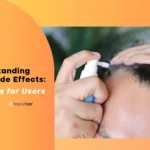Can You Regain Hair Growth? Everything You Need to Know

The average human has between 100,000 and 150,000 hairs on their heads. Losing up to 100 of these strands per day is a normal part of the hair life cycle. This begins with the anagen (growth) phase, before progressing onto the catagen (resting) phase, followed by telogen (shedding).
However, anything that disrupts this process causes significantly more hair fall, leading to excessive thinning and, eventually, balding. Not only could this indicate an underlying health concern, but hair loss can also put a huge dent in your confidence levels.
Luckily, there are actions you can take to slow down thinning and stop hair loss in its tracks. In some cases, you may even be able to regrow hair that’s already fallen out – keep reading to find out how and why this is possible.
What Causes Hair Loss?
Androgenetic alopecia, or male pattern baldness, is the most common hair loss condition, affecting up to 50% of men by the age of 50. Thinning hair is the initial sign, followed by a receding hairline and hair loss at the crown.
Male pattern baldness is triggered by a genetic sensitivity to the sex hormone dihydrotestosterone (DHT). This shrinks hair follicles and shortens the anagen hair growth phase.
Alopecia areata is another common condition that causes hair to fall out in small patches across the scalp. This occurs when your immune system mistakenly attacks hair follicles.
Excess shedding is often caused by telogen effluvium (TE), which can be triggered by stress, infection, nutritional deficiency, major surgery, hormonal changes, or a reaction to new medications.
TE pushes a large number of hairs from the anagen (growth) phase into the telogen (resting phase).
[elementor-template id=”9678″]
Can You Regrow Hair?
Whether or not growth is possible depends on the initial cause of your hair loss.
Hair grows from follicles, which are tiny pockets on the scalp. If these hair follicles have closed or disappeared, then new strands won’t be able to grow.
This most commonly occurs with permanent hereditary hair loss conditions like male pattern baldness. However, regrowth may be possible in the future, thanks to the development of technologies that clone hair follicles and inject them into thinning areas.
If the follicle remains intact, even with thin or damaged strands, then hair regrowth is possible. Catching hair loss in its early stages with a targeted medical treatment can also slow down or even stop the process entirely.
As a reversible condition, telogen effluvium can resolve itself in around 6 to 8 months, but may return if emotional stress isn’t properly dealt with or managed.
Autoimmune conditions like alopecia areata are more unpredictable, as it’s not known specifically what causes the immune system to attack the hair follicles. Without further research in the future, it’s therefore not currently possible to predict whether hair regrowth will occur with this condition.
How to Stimulate Hair Growth
Unless your thinning hair is caused by a genetic condition, new hair growth can be activated by making some simple lifestyle changes. Here are 4 tips for encouraging regrowth:
1. Build a Hair Care Routine
Consistency is key when it comes to restoring thinning hair, helping to promote thickness and volume.
Using hair growth serums with natural ingredients such as caffeine and saw palmetto can help your hair stay in the anagen phase for longer, while also keeping strands strong and hydrated.
Products containing essential oils can also boost blood flow to the scalp, which lengthens the anagen hair growth phase. Coconut and castor oil have anti-inflammatory properties, therefore preventing shedding by shortening the telogen stage.
A randomised controlled trial also found rosemary oil to be as effective as 2% minoxidil, a clinically proven hair loss treatment for androgenetic alopecia.
Look for hair growth shampoos and conditioners that are made with B vitamins and proteins like biotin, keratin, and collagen.
As well as removing excess product or dirt build-up from the scalp, these ingredients nourish hair from the inside out by plumping the hair shaft. Some shampoos and conditioners also contain DHT blockers, which prevent the hormone from shrinking hair follicles.
Try to avoid using heat where possible, as this can damage and dry out the hair, therefore causing breakage. Tight hairstyles also cause traction alopecia.
2. Eat a Balanced Diet
Hair loss caused by nutrient deficiency is common among those who fail to eat a diet balanced with healthy fats and proteins, as well as vitamins and minerals.
One of the most common deficiencies that triggers hair thinning is iron, especially if you consume a vegan or vegetarian diet. Zinc, vitamin B12, and vitamin D deficiencies are also directly linked with brittle hair.
Some of the best foods for preventing these deficiencies and stimulating healthy hair regrowth include:
- Spinach
- Avocados
- Nuts and seeds
- Eggs
- Beans
- Berries
- Fatty fish like salmon and mackerel
3. Try Supplements
Another way to tackle vitamin and mineral deficiency is with supplements. They contain essential nutrients such as vitamin D, which creates hair follicle cells, and vitamin C, a water-soluble nutrient that helps your body absorb iron from food.
However, over-supplementation can be harmful; for example, excessive vitamin A intake is not only toxic, but it may also cause hair loss. Consult a healthcare professional before adding any supplements to your routine.
4. Lower Stress Levels
Chronic stress impacts the growth of hair follicle stem cells by keeping them in an extended resting phase. This occurs due to an increase in levels of corticosterone, a stress hormone.
A study into the prevalence of hair loss found that 73.8% of participants reported experiencing stress, as well as psychosocial factors like financial difficulties that trigger poor mental health. Those with higher stress levels also exhibited more severe hair loss.
Getting plenty of sleep, exercising regularly, and meditation are all effective methods for tackling stress.
[elementor-template id=”9673″]
Medical Treatments for Hair Regrowth
The treatments discussed above can help to promote natural hair regrowth.
However, they may not work in the later stages of hereditary hair loss or for those with an underlying medical condition. These require a targeted hair loss treatment that’s designed to address the specific cause.
Visit a doctor or dermatologist who can suggest or prescribe one of the following treatments to help you regrow hair effectively:
Topical Treatments
Originally created as an oral medication for high blood pressure, minoxidil, or Rogaine, boosts blood flow to the scalp.
It achieves this through vasodilation, the widening of blood vessels, which allows more oxygen and essential nutrients to reach the scalp and support thicker hair follicles.
Topical minoxidil also prolongs the anagen phase, making it the main hair loss treatment for androgenetic alopecia. This liquid or spray solution also reactivates hair follicles for those experiencing thinning through stress, medical conditions, or hormonal changes.
Other topical treatments that a doctor may prescribe include antifungal shampoos, which tackle hair loss caused by conditions like ringworm or dandruff.
Oral Medications
Finasteride (Propecia) is the only prescription medication currently approved by the FDA to treat male pattern baldness. Taken orally, finasteride inhibits the activity of 5-alpha reductase, an enzyme that converts testosterone into DHT.
In a study of over 2500 men affected by long-term androgenetic alopecia, 87.1% observed hair growth after taking 1mg of finasteride per day over a 3-year period.
Platelet-Rich Plasma Therapy
Platelet-rich plasma therapy (PRP) is a medical treatment that involves injecting plasma cells from your blood into the scalp.
While often used to heal injured tendons or muscles, PRP can stimulate hair growth by boosting blood supply to the hair follicle. It may also prevent shredding and boost hair thickness and density.
Long-Term Treatment Plans
Long-term hair loss treatments are one of the best solutions, since they come in powerful formulations designed to stimulate lasting regrowth.
However, these treatments require a prescription and regular check-ins at your doctor’s office. If you’d rather avoid these frequent clinical visits and are looking for a more convenient, discreet solution, the Hairy Hair plan makes an ideal choice.
Sign up to Hairy Hair and you’ll receive a delivery of single daily pills straight to your door, allowing you to stimulate regrowth from home. Users also get access to a personalised haircare plan and free online consultations with a qualified Australian GP.
Final Thoughts
Hair growth can be regained if treated early, depending on the root cause of your hair loss.
Although male pattern baldness is treatable with clinically proven medications and topical formulas, slowing or preventing hair loss will be more difficult if the damage is significant. Temporary hair loss conditions such as telogen effluvium can be tackled with healthy lifestyle changes, from lowering stress levels to eating a more balanced diet.
Speak to a healthcare professional if you’re unsure of how to activate regrowth, who can recommend the most effective and safest approach for your specific type of hair loss. Learn more by checking our website!
In This Article
Overview
Most Trending Articles


